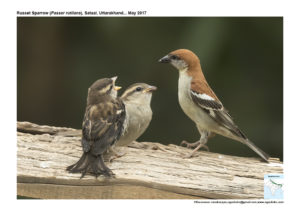Russet Sparrow

Russet Sparrow Passer rutilans
Etymology:
- Passer : Latin word for Sparrow
- Rutilans : Latin word for glowing reddish colour derived from rutilus- auburn, red
Vernacular names: Hindi: Lalgouriya, Ass: Pichi, Mani: Sendang, Tibetan: Kang-che-go-ma, Naga: Inkurui
Distribution in India: Resident of Himalayas and North Eastern hills inIndia.
Description: Size 14–15 cm; wt. of 13–23 g. The male breeding has bright cinnamon-brown or russet on top of head to hindneck and upperparts, heavily streaked black on mantle. The lores are black, ear-coverts and cheeks are off-white; lesser upperwing-coverts are back, median coverts are black with broad white tips, greater coverts are blackish with broad buffish edges and narrow pale buff tips. The flight-feathers are blackish, secondaries and tertials are edged buffish, small pale patch at base of primaries. The tail is dull brownish or grey-brown, feathers are with narrow pale edges and tips. The chin and throat are black, underpartsare off-white; iris is dark brown; bill is black; legs are pale brown to pinkish-brown. The non-breeding male is like the breeding male, but plumage pattern partially obscured by pale feather tips, bill is horn-coloured. The female is sandy brown to dull cinnamon above, with very conspicuous long, bright creamy supercilium, broad pale and dark stripes on mantle, white chin and throat, yellowish bill with dark tip. Thejuvenile is similar to female, but duller.
Habitat: It is found in light woodland, terrace cultivation around edges of villages, and more open parts of built-up areas. It is found from 1000 m to 4300 m, breeding mostly to 2300 m, down to edge of plains, to 500 m, in non-breeding season.
Food habits: It eats seeds, cultivated cereals and also small berries. The nestlings are fed exclusively with animal food, mainly caterpillars and grubs. It obtains insect items by searching leaves and, by seizing them in flight. It collects in large flocks in winter to feed on spilt grain and weed seeds in stubbles of cultivated fields.
Breeding habits: They breed in Apr–Jul in Himalayas.They lay two broods and are solitary nesters. The nest is built by both sexes. The nest is an untidy collection of grass, lined with hair and feathers, placed in hole, mainly in tree. They lay a clutch of 4–6 eggs. The incubation of eggs and tending of young is done by both parents.